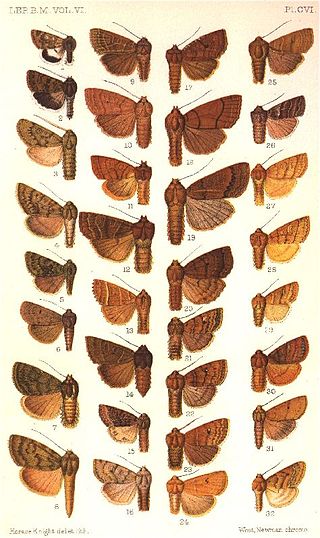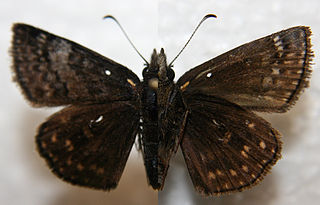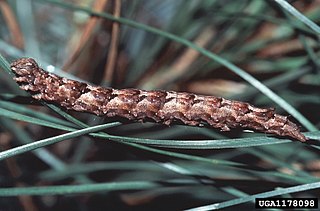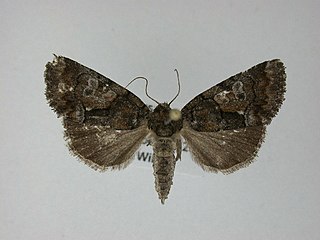
Waldsteinia fragarioides (syn. Dalibarda fragarioides Michx. and Geum fragarioides, also called Appalachian barren strawberry, or just barren strawberry, is a low, spreading plant with showy yellow flowers that appear in early spring. This plant is often used as an underplanting in perennial gardens.

Acronicta lanceolaria, the lanceolate dagger moth or pointed dagger, is a moth of the family Noctuidae. The species was first described by Augustus Radcliffe Grote in 1875. It is found in North America, from Nova Scotia to British Columbia. It is listed as a species of special concern and believed extirpated in the US state of Connecticut.

Psectraglaea is a monotypic moth genus of the family Noctuidae described by George Hampson in 1906. Its only species, Psectraglaea carnosa, the pink sallow, described by Augustus Radcliffe Grote in 1877, is native to North America. It is listed as threatened in Connecticut, and as a species of special concern in Massachusetts.

Erynnis brizo, the sleepy duskywing or banded oak duskywing, is a species of Hesperiidae butterfly that occurs throughout North America and is commonly confused with E. juvenalis and E. lucilius. The species is listed as threatened in Connecticut and Maine.

Metarranthis is a genus of moths in the family Geometridae first described by Warren in 1894.
Abagrotis nefascia is a moth of the family Noctuidae first described by Smith in 1908. It is found in North America from Alberta and British Columbia down through Massachusetts to California. The species is listed as threatened in the US state of Connecticut.

Argyrostrotis anilis, the short-lined chocolate, is a moth of the family Noctuidae. The species was first described by Dru Drury in 1773. It is found in North America from Quebec and Ontario, down through the eastern United States to Florida and Texas. It is listed as a species of special concern in the state of Connecticut.

Acronicta albarufa, the barrens dagger moth, is a moth of the family Noctuidae. It has a fragmented distribution in North America that includes southern Ontario and Manitoba, New York, New Jersey, Massachusetts, North Carolina, Virginia, Georgia, Oklahoma, Missouri, Arkansas, and Colorado. It may also be present in Ohio, Pennsylvania, Connecticut, mainland New York and New Mexico. It has been suggested that populations in the south-western United States may be a separate species. It is listed as a species of special concern and believed extirpated in the US state of Connecticut.

Acronicta falcula, the corylus dagger moth, is a moth of the family Noctuidae. The species was first described by Augustus Radcliffe Grote in 1877. It is found in the United States and Canada from southern New England to southern Manitoba and Iowa. Recently seen from Wisconsin, Connecticut, Rhode Island, New York and Michigan. It is reported as rare in Ohio. It is listed as a species of special concern in the US state of Connecticut.

The pink star moth is a species of moth of the family Noctuidae. It is found from southern Maine to Florida, west to Missouri and Texas.

Zanclognatha martha, the pine barrens zanclognatha or Martha's zanclognatha, is a litter moth of the family Erebidae. It was described by William Barnes in 1928. It is found from Ohio to Maine, south in the mountains to North Carolina and along the Coastal Plain to Texas. It is listed as threatened in the US state of Connecticut.

Zale submediana, the gray spring zale, is a moth of the family Noctuidae. The species was first described by Embrik Strand in 1917. It is found in the US from Wisconsin to Maine, south to New Jersey and in mountains to North Carolina.
Apodrepanulatrix liberaria, the New Jersey tea inchworm, is a moth in the family Geometridae. It was described by Francis Walker in 1860. It is found from extreme southern Quebec and southern Ontario southward into northern Florida and Mississippi. It is listed as endangered by state authorities in the US states of Massachusetts and Connecticut.

Chytonix sensilis, the barrens chytonix, is a species of moth of the family Noctuidae found in North America. It ranges from Quebec to Florida, and from Michigan to Texas. It was first described by Augustus Radcliffe Grote in 1881 and is now listed as endangered in the US state of Connecticut.
Papaipema marginidens, the brick-red borer moth, is a species of moth found in North America. It was first described by Achille Guenée in 1852. It is found in eastern North America, from Pennsylvania and New York south to Georgia and North Carolina. It is now listed as endangered in the US state of Connecticut. The habitat consists of a mixture of open oak woodlands and barrens in rocky areas with herbaceous undergrowth- especially along streams.
Speranza exonerata, the barrens itame, is a moth of the family Geometridae described by Douglas C. Ferguson in 2008. It is found in Massachusetts, New Hampshire, Pennsylvania and New Jersey. It is listed as threatened in the US state of Connecticut.

Glena cognataria, the blueberry gray moth, is a moth native to North America. It ranges from Florida to Nova Scotia and New Brunswick. Its larvae is hosted on blueberry. The habitat consists of bogs and pine barrens. It is listed as a species of special concern and believed extirpated in the US state of Connecticut.

Dargida rubripennis, the pink streak, is a species of moth in the family Noctuidae. It was described by Augustus Radcliffe Grote and Coleman Townsend Robinson in 1870. It is found in the eastern United States, ranging to Kansas and Texas. It is listed as threatened in the US states of Massachusetts and Connecticut. The wingspan is 32–37 mm.

Sideridis maryx the maroonwing moth, is a species of moth native to North America. In the US state of Connecticut, it is listed as a species of special concern and is believed to be extirpated. The larval food plant is unknown, but it is suspected to be a specialist feeding on Arctostaphylos uva-ursi. The species was first described by Achille Guenée in 1852.
Apamea lintneri, the sand wainscot moth, is a species of moth native to North America. It is listed as a species of special concern in the US state of Connecticut. The species was described by Augustus Radcliffe Grote in 1873.












